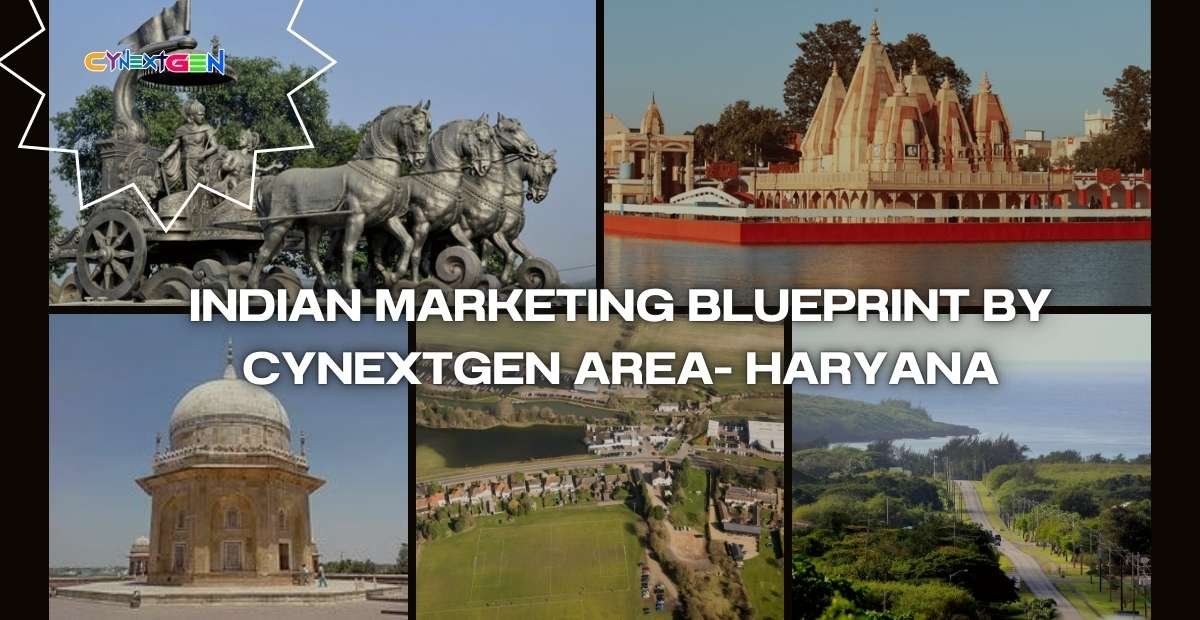
Indian Marketing Blueprint by Cynextgen: Area – Haryana
As part of the Indian Marketing Blueprint by Cynextgen, we bring to you an in-depth marketing blueprint for Haryana, a state that uniquely blends urban sophistication with rural traditions. Haryana’s strategic location near Delhi, a young population, and rising digital adoption make it a crucial market for brands seeking growth in India. From Gurugram’s high-end corporate landscape to the agrarian belts of Hisar and Jind, Haryana offers diverse consumer behavior patterns, requiring tier-wise, region-specific marketing strategies.
Who Are Haryana’s Digitally Active Users?
Haryana boasts over 25 million internet users, driven by the rising penetration of smartphones. Gurugram and Faridabad are digital hubs, with strong adoption of social media, e-commerce, and fintech solutions. Semi-urban towns like Panipat, Hisar, and Rohtak are quickly catching up due to the availability of affordable data plans, while rural areas are witnessing steady growth in smartphone usage, particularly among young people and farmers who are leveraging agri-tech apps.
Social engagement in Haryana is varied: the urban population heavily consumes content on Instagram, YouTube, Facebook, and WhatsApp, whereas regional short-video apps like ShareChat, Moj, and Josh are gaining traction in Tier 2 and Tier 3 towns. E-commerce is also flourishing, with Amazon, Flipkart, Meesho, and JioMart catering to both urban and semi-urban customers.
OTT consumption is high across the state, with sports, Hindi cinema, and Haryanvi content driving subscriptions on platforms like Hotstar, SonyLIV, and Netflix. Gaming trends such as BGMI, Free Fire, and YouTube Shorts are particularly popular among the youth.
What Makes Haryana Famous for FMCG?
Haryana has a strong dairy culture, making it a hotspot for FMCG brands. Milk, ghee, curd, and lassi consumption is exceptionally high in both urban and rural areas. Premium FMCG products are primarily concentrated in Gurugram and Faridabad, whereas rural belts like Jind, Karnal, and Bhiwani are driving demand for affordable packaged foods and household essentials.
| Category | Urban Demand | Rural Demand | Key Opportunity |
| Dairy Products | High-quality milk, ghee, flavoured milk | Basic milk, ghee, curd | Expand premium & local distribution |
| Snacks & Beverages | Packaged snacks, cold drinks | Affordable snacks, juices | Affordable D2C options |
| Personal Care | Skincare, wellness | Basic hygiene products | Tiered marketing for urban/rural |
| Household Products | Cleaning, kitchenware | Essential household items | Regional campaigns & affordability |
The FMCG market in Haryana is therefore tier-segmented, requiring a mix of premium positioning in metros and affordability-focused campaigns in rural regions.
Where Can Different Businesses Succeed in Haryana?
Urban centers like Gurugram, Faridabad, and Panchkula are ideal for premium FMCG, real estate, fintech, ed-tech, and luxury retail brands. Semi-urban towns such as Panipat, Hisar, and Rohtak are rapidly emerging as fast-growing markets for mid-tier D2C brands, particularly in the apparel, health, and wellness sectors. Rural belts, including Jind, Sonipat, and Bhiwani, are perfect for affordable FMCG, agri-tech solutions, mobile phones, and healthcare products.
This tier-based segmentation enables marketers to design targeted campaigns, resulting in higher ROI and stronger brand recall.
How Does Spending Power Vary Across Haryana?
In Gurugram, young professionals and youth spend heavily on gadgets, fashion, fitness, OTT subscriptions, and food delivery. Tier 2 cities such as Rohtak, Panipat, and Ambala see youth focusing on affordable fashion, gaming, and data packs. Meanwhile, rural youth primarily invest in education apps, mobile recharges, and agri-related digital solutions, indicating an opportunity for ed-tech and fintech brands to penetrate the market more deeply.
Which Booming Market Segments Should You Watch?
- Electric Vehicles (EVs) & Mobility: Gurugram is emerging as an EV hub, supported by government-backed policies and growing charging infrastructure.
- Health & Fitness: Yoga centers, gyms, protein supplements, and ayurvedic wellness products are experiencing rapid adoption across urban and semi-urban populations.
- Regional Content & Entertainment: Haryanvi music, YouTube channels, and OTT content are gaining traction, presenting opportunities for influencer marketing.
- E-commerce & D2C Growth: Semi-urban towns are showing a rising demand for affordable yet aspirational products through digital channels.
Why Is Haryana Attractive for Future Growth?
- EV Adoption: Gurugram and Faridabad are leading in EV and charging infrastructure.
- Smart Cities: Panipat, Karnal, and Hisar are witnessing innovative city initiatives that attract startups and modern retail.
- Agri-Tech Solutions: Precision farming, irrigation tech, and rural fintech solutions are expected to scale rapidly.
- Startups: Gurugram remains a thriving hub for fintech, SaaS, logistics, and lifestyle startups.
How Can Brands Capture Haryana’s Audience?
Brands must adopt tier-wise and culturally relevant marketing strategies. Using Haryanvi content resonates with local audiences, while urban campaigns can leverage aspirational messaging. Festivals such as Teej, Holi, Diwali, and harvest celebrations present ideal opportunities for product launches. Youth-driven campaigns, including gaming tie-ups, campus influencers, and regional content collaborations, can increase brand penetration.
Campaign strategies include:
- Influencer collaborations with Haryanvi singers and YouTubers.
- WhatsApp referral campaigns targeting semi-urban and rural areas.
- Sports-linked advertising, focusing on Kabaddi and wrestling events.
- Participation in local fairs, jat gatherings, and cultural shows for higher visibility.
What Can We Learn from Regional Brand Case Studies?
Success Stories:
- Amul: Leveraged Haryana’s dairy culture and strengthened digital presence through Swiggy and Zomato tie-ups, making Haryana a stronghold in northern India.
- Desi Records (Local Haryanvi Music Label): Gained massive traction through YouTube and Instagram Reels, effectively monetizing regional content.
Failures:
- Several small grocery delivery startups in Gurugram (2018–19) struggled due to high logistics costs and limited market scale beyond metro corridors.
How Does Culture & Festivals Influence Marketing?
Haryana’s festival culture provides numerous opportunities for brands. Women-centric festivals like Teej and Baisakhi are ideal for lifestyle and FMCG promotions. Diwali and Holi are accompanied by widespread consumer spending in both urban and rural areas. Haryana’s sports culture, particularly Kabaddi, wrestling, and boxing, offers a unique platform for endorsements. Regional music, folk dance, and cinema can amplify influencer-driven campaigns, giving brands a culturally authentic edge.
Conclusion: Why Haryana Should Be On Your Marketing Radar
Haryana presents a dynamic marketing landscape where urban sophistication meets rural opportunity. Brands that successfully navigate tier-specific campaigns, leverage regional influencers, and integrate cultural context can drive higher engagement, stronger brand loyalty, and measurable ROI.
From premium EV campaigns in Gurugram to affordable FMCG promotions in rural belts, Haryana offers a diverse playground for innovative marketing strategies. The DIGITALBHARAT Project by Cynextgen highlights that with data-driven insights, region-specific approaches, and a digital-first strategy, brands can capture the full potential of Haryana’s young, tech-savvy, and culturally rooted population.




Add Comment